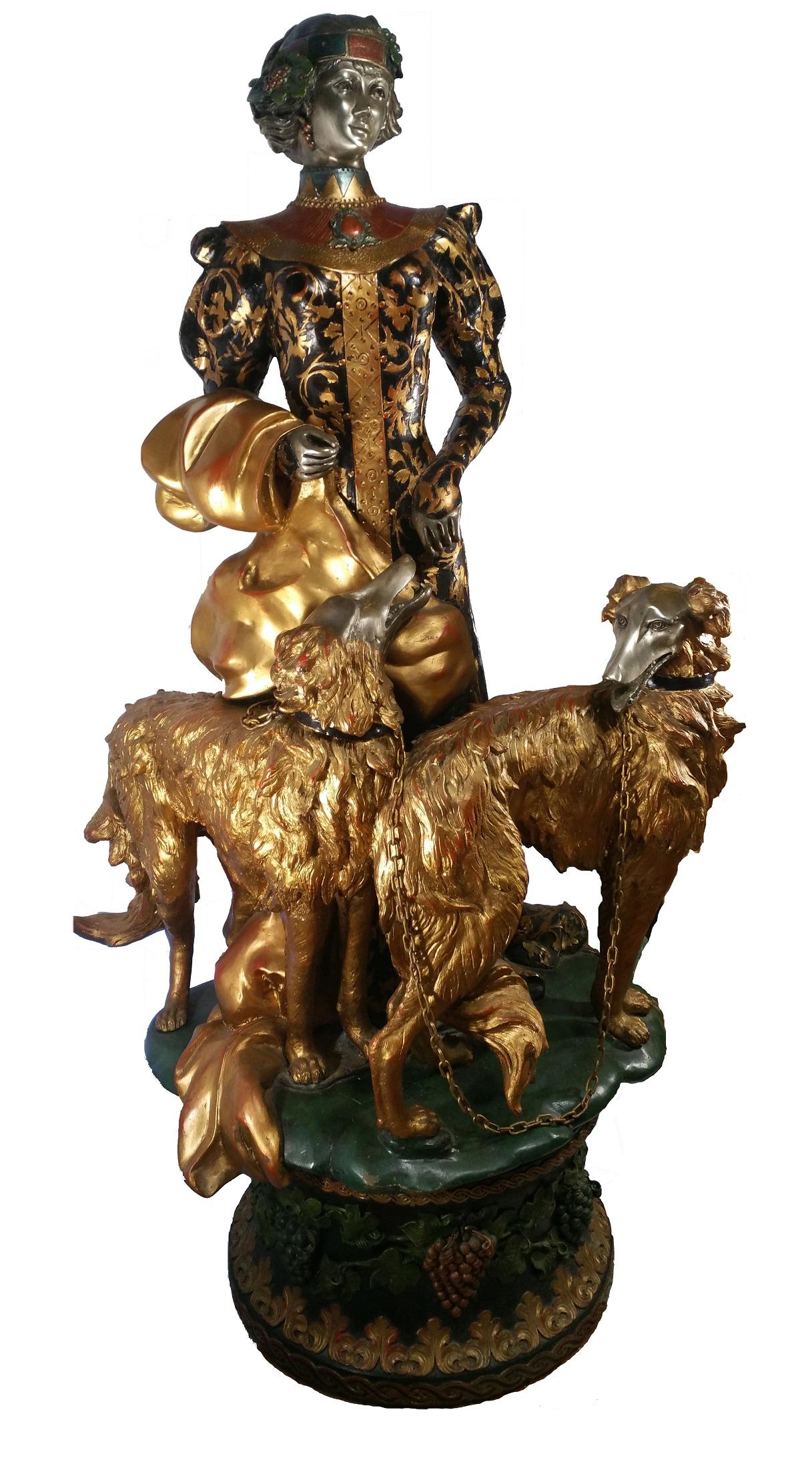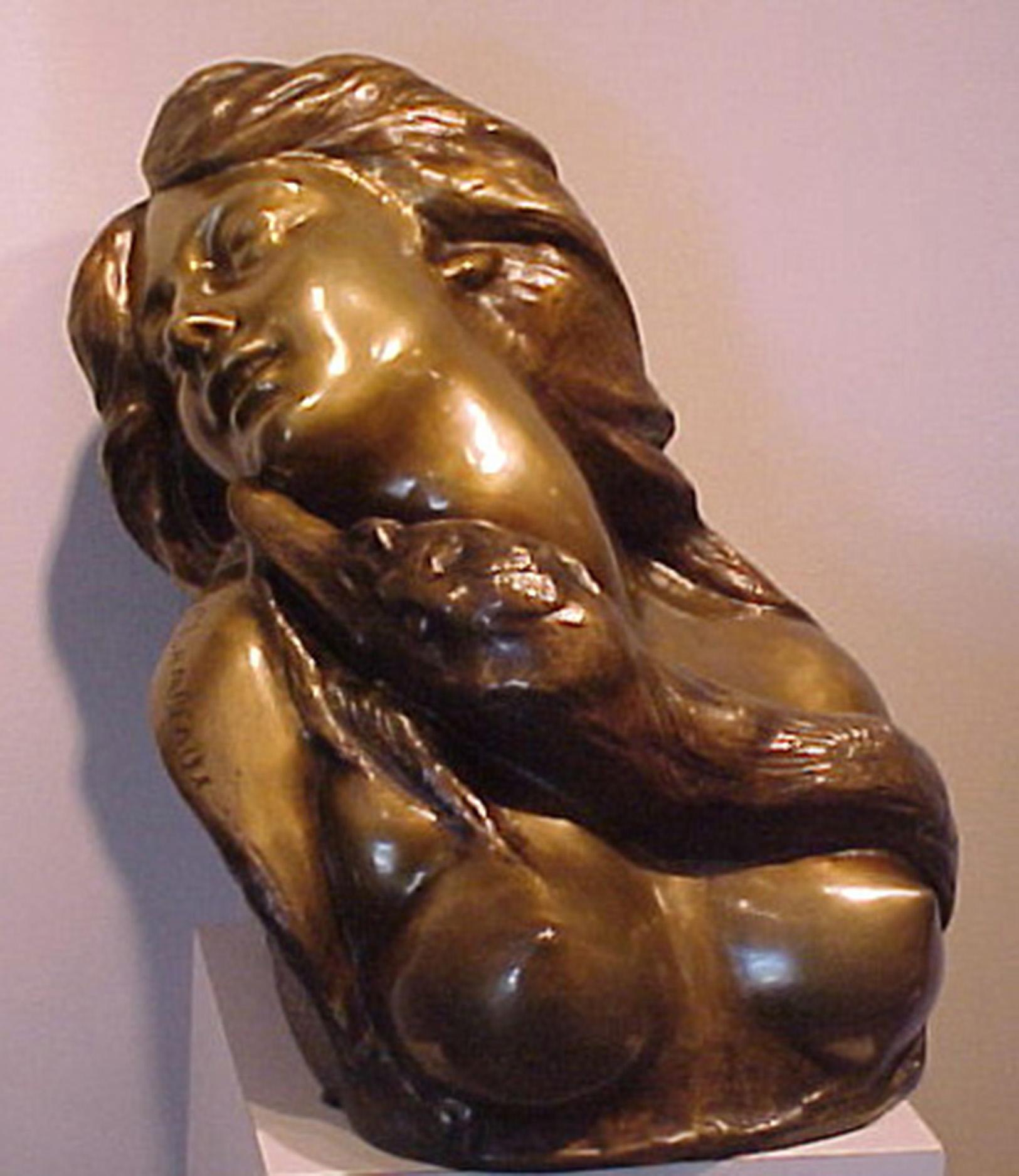Items Similar to La Cothurne
Want more images or videos?
Request additional images or videos from the seller
1 of 9
Agathon LéonardLa Cothurne1901
1901
About the Item
"La Cothurne" 1901
Gilt Bronze
Approx 21.5" High (to raised hand)
Signed and Dated
Foundry Mark "Susse Freres"
Originally modeled in white biscuit porcelain this Greek dancer is a from a set of eight created for a dining table. They were immediately successful when they were exhibited in the Sevres pavilion at the 1900 Exhibition. Individual figures could be ordered and "La Cothurne" proved the most popular. Their success led to the firm of Susse buying the right to cast versions in metal.
Agathon Leonard (1841-1923) is one of the well-known French Art Nouveau sculptors. Born in Lille in 1841, he first studied there before moving to Paris where he studied at the Ecole des Beaux Arts under Eugene Delaplanche.
He gained recognition at the annual Expositiones Universelles, winning a Silver Medal there in 1889 and gold in 1900. His most important piece, Jeu L'echarpe, was the best known series of Sevres production at the turn of the century and sold out at the 1900 Expo in Paris and later was given as a gift by the French Gov't to Nicholas II at the Hermitage.
His bronzes were cast at the Susse Freres Editeurs Foundry. He worked also in marble, quartz and ivory. He also produced Art Nouveau medallions, statuettes and pottery.
His work is held at the Victoria & Albert Museum, the Art Institute of Chicago, and Abbeville and Nantes Museums.
He became a member of the Societe des Artistes Francois in 1887 and the Society Nationale des Beaux-Arts in 1897. He was made a chevalier of the Legion d'Honneur in 1900.
- Creator:Agathon Léonard (1841 - 1923, French)
- Creation Year:1901
- Dimensions:Height: 21.5 in (54.61 cm)Width: 6 in (15.24 cm)
- Medium:
- Movement & Style:
- Period:
- Condition:
- Gallery Location:Missouri, MO
- Reference Number:1stDibs: LU74732666973
About the Seller
5.0
Vetted Seller
These experienced sellers undergo a comprehensive evaluation by our team of in-house experts.
Established in 1970
1stDibs seller since 2017
142 sales on 1stDibs
Typical response time: 20 hours
- ShippingRetrieving quote...Ships From: Missouri, MO
- Return PolicyA return for this item may be initiated within 2 days of delivery.
More From This SellerView All
- Study AimBy Carl KaubaLocated in Missouri, MOCarl Kauba "Study Aim" c. 1920 Bronze with Brown Patina Signed approx. 9.5 x 10 x 4 This Austrian sculptor was born in Vienna in 1865. His teachers were Karl Waschmann (1848-1905), known for his ivory sculptures and portrait plaquettes of contemporary celebrities, and Stefan Schwartz (1851-1924), who exhibited in Paris, including the Exposition Universelle of 1900 where he won a gold medal. Kauba's intricate bronzes, imported to the United States between 1895 and 1912, were cast at the Roman Bronze Works. Kauba was part of the nineteenth-century tradition of polychrome bronze sculpture. There were several types of patinas on a single statue: he could render the color of buckskin, variously tinted shirts, blankets, feathers, as well as beaded moccasins. Reportedly, Kauba came to America around 1886. Inspired by the Western tales of German author Karl May, he traveled to the West and made sketches and models. Critics, however, pointed out inaccuracies of costume and other details. For instance, the guns that his "mid-nineteenth-century" figures use are models produced after 1898. Apparently he did all of his works back in Vienna. Besides the variety of color, Kauba's bronzes show a great range of textures and his style is highly naturalistic. The sculptor loved ornament, some of which he rendered with coiled wire for reins, rope and feathers in headdresses. He successfully rendered figures in motion and often executed compositions with more than one figure. Berman (1974) illustrates non-Western subjects by Kaula, such as the pendants Where? and There (ca. 1910), a seated Scottish couple, impressive in the expressions and the details on patterned fabrics of both sitters. Another genre piece is Buster Brown...Category
Early 20th Century Realist Figurative Sculptures
MaterialsBronze
- Going into BattleBy Carl KaubaLocated in Missouri, MOCarl Kauba "Going into Battle" c. 1920s Bronze with Brown Patina Signed approx 10 x 10 x 4 (including wooden base) This Austrian sculptor was born in Vienna in 1865. His teachers were Karl Waschmann (1848-1905), known for his ivory sculptures and portrait plaquettes of contemporary celebrities, and Stefan Schwartz (1851-1924), who exhibited in Paris, including the Exposition Universelle of 1900 where he won a gold medal. Kauba's intricate bronzes, imported to the United States between 1895 and 1912, were cast at the Roman Bronze Works. Kauba was part of the nineteenth-century tradition of polychrome bronze sculpture. There were several types of patinas on a single statue: he could render the color of buckskin, variously tinted shirts, blankets, feathers, as well as beaded moccasins. Reportedly, Kauba came to America around 1886. Inspired by the Western tales of German author Karl May, he traveled to the West and made sketches and models. Critics, however, pointed out inaccuracies of costume and other details. For instance, the guns that his "mid-nineteenth-century" figures use are models produced after 1898. Apparently he did all of his works back in Vienna. Besides the variety of color, Kauba's bronzes show a great range of textures and his style is highly naturalistic. The sculptor loved ornament, some of which he rendered with coiled wire for reins, rope and feathers in headdresses. He successfully rendered figures in motion and often executed compositions with more than one figure. Berman (1974) illustrates non-Western subjects by Kaula, such as the pendants Where? and There (ca. 1910), a seated Scottish couple, impressive in the expressions and the details on patterned fabrics of both sitters. Another genre piece is Buster Brown...Category
Early 20th Century Realist Figurative Sculptures
MaterialsBronze
- The Hunter and HoundBy Pierre Jules MêneLocated in Missouri, MOPierre-Jules Mene "The Hunter and Hound" (Le Valet de Limier) 1879 Bronze approx. 19 x 8 x 14 inches Signed PIERRE JULES MENE (1810-1879) Pierre...Category
1870s Realist Figurative Sculptures
MaterialsBronze
- Preparing to RideLocated in Missouri, MOPreparing to Ride By. George B. Marks (American, 1923-1983) Signed and Dated Throughout his artistic career, George Marks’s work was always guided by the...Category
1970s American Realist Figurative Sculptures
MaterialsBronze
- Native American Girl with DollBy Dave PowellLocated in Missouri, MONative American Girl with Doll By Dave Powell (American, b. 1954) Signed on Back 17.5" x 8" Dave Powell is a native son of Montana, in a world of change and transition; few can say they have roots in a single geography that go back four generations. Dave's pedigree in art is just about as deep. He is the son of artists Ace Powell and Nancy McLaughlin Powell. That heritage leads back to the likes of Charlie Russell and Joe De Young, both famous for their abilities to "tell the story" through their art. His father, Ace Powell, was a prolific Western artist whose first childhood paint-box set was a gift from Charlie and Nancy Russell. Dave became a serious student of art in his mid-teens, and has been a professional artist most of his adult life. Over the years he has worked with Bob Scriver, Ned Jacob and Robert Lougheed. Dave will be the first to give thanks...Category
20th Century American Realist Figurative Sculptures
MaterialsBronze
- Leda and the SwanBy Albert-Ernest Carrier-BelleuseLocated in Missouri, MOAlbert-Ernest Carrier-Belleuse (French, 1824-1887) "Leda and the Swan" c .1858 Bronze w/Gold Patina 18 x 24 x 14 Signed "A. Carrier" Based upon a c...Category
Late 19th Century Victorian Figurative Sculptures
MaterialsBronze
You May Also Like
- Woman with Two Borzoi DogsLocated in Saratoga Springs, NYMonumental, Art Nouveau, Bronze Sculpture – Anonymous (20th Century) “Woman with Two Borzoi Dogs” 6 feet 7 inches high x 3 feet 3 inches wide x 2 feet 5 inches wide Medium: Silvered, patinaed and painted bronze Provenance: Maxwell House...Category
1930s Art Nouveau Figurative Sculptures
MaterialsBronze
- Antique French Art Nouveau Bronze Female Bust "Phryne" Emanuel Villanis 1900By Emmanuel VillanisLocated in Portland, ORAntique, Art Nouveau bronze of a beautiful maiden in the Neo-Classical manner by Emmanuel Villanis, Circa 1900. The bronze, titled "Phryne" depicts a beautiful Neo-Classical maiden, ...Category
Early 1900s Art Nouveau Figurative Sculptures
MaterialsBronze
- Leda and the SwanLocated in West Hollywood, CAPresenting a magnificent early Art Nouveau bronze by Belgian artist Jef Lambeaux(1852-1908.) “Leda and the Swan”, is an original Art Nouveau Bronze,...Category
1880s Art Nouveau Figurative Sculptures
MaterialsBronze
- "A Girl Bust" 20th Century Bronze Sculpture by Spanish Artist Juan Clará AyatsLocated in Madrid, ESJUAN CLARÁ AYATS Spanish, 1878 - 1958 A GIRL BUST signed "Juan Clara" and Buenos Aires stamp mark (on the back ) bronze figure 6-3/8 x 4-1/8 x 4-1/8 inches (16 x 10.5 x 10.5 cm.) 8 x 4-1/8 x 4-1/8 inches (20 x 10.5 x 10.5 cm.) base included PROVENANCE Private Spanish Collector Art Noveau bronze...Category
1920s Art Nouveau Figurative Sculptures
MaterialsBronze
- "Art Nouveau Sculptural Bronze Group of Children", 20th Century by Juan ClaráLocated in Madrid, ESJUAN CLARÁ AYATS Spanish, 1878 - 1958 ART NOUVEAU BRONZE GROUP OF CHILDREN signed "Juan Clara" (lower right on the bench) bronze sculpter group 4-3/4 x 6 x 3-1/2 inches (12 X 15 X 9 cm.) PROVENANCE Private Spanish Collector Juan Clará's Art Nouveau bronze sculptural group representing two boys and a girl sitting on a bench in a funny and surprise attitude to something they are seeing. Juan Clará's Art Nouveau bronze sculptural group representing two boys and a girl sitting on a bench in a funny and surprise attitude to something they are seeing. Juan Clará Ayats. Olot (Gerona), 6.XII.1875 - Paris (France), II.1958. Sculptor Student of José Berga at the Olot School of Fine Arts, developed his training in France, first at the School of Fine Arts in Toulouse, in 1896, and from 1901 in Paris. At this stage he lived with his younger brother, José Clará...Category
1920s Art Nouveau Figurative Sculptures
MaterialsBronze
- "A Girl Sitting on a High Chair" 20th Century Bronze Sculpture by Juan ClaráLocated in Madrid, ESJUAN CLARÁ AYATS Spanish, 1878 - 1958 A GIRL SITTING ON A HIGH CHAIR signed "Juan Clara" (on the back of the chair ) bronze figure 8-3/4 x 7-1/8 x 4-3/4 inches (22 X 18 X 12 cm.) PROVENANCE Private Spanish Collector A young girl sitting on a high chair, with a naughty attitude that wants to escape from the high chair. She is making a great effort to get rid of the bars of the high chair, just as her whole body accompanies her to this effort. The candid and innocent attitude of the girl, but at the same time fun and mocking we love and conquer. Juan Clará Ayats. Olot (Gerona), 6.XII.1875 - Paris (France), II.1958. Sculptor Student of José Berga at the Olot School of Fine Arts, developed his training in France, first at the School of Fine Arts in Toulouse, in 1896, and from 1901 in Paris. At this stage he lived with his younger brother, José Clará...Category
1920s Art Nouveau Figurative Sculptures
MaterialsBronze
Recently Viewed
View AllMore Ways To Browse
1900 Exhibition
Ivory Art D
Medallion Sculpture
Art Nouveau Dancers
Art Nouveau Marble Sculptures
Art Nouveau Ivory
Antique Ivory Sculpture
Antique Ivory Sculptures
Statuettes Gold
Art Nouveau Medallions
Sculpture Biscuit
Bronze And Ivory Sculpture
Biscuit Porcelain Sculptures
Art Nouveau French Pottery
Marble Sevres
French Provence Pottery
Sculpture Porcelain Dancer
White And Gold Sevres Porcelain

